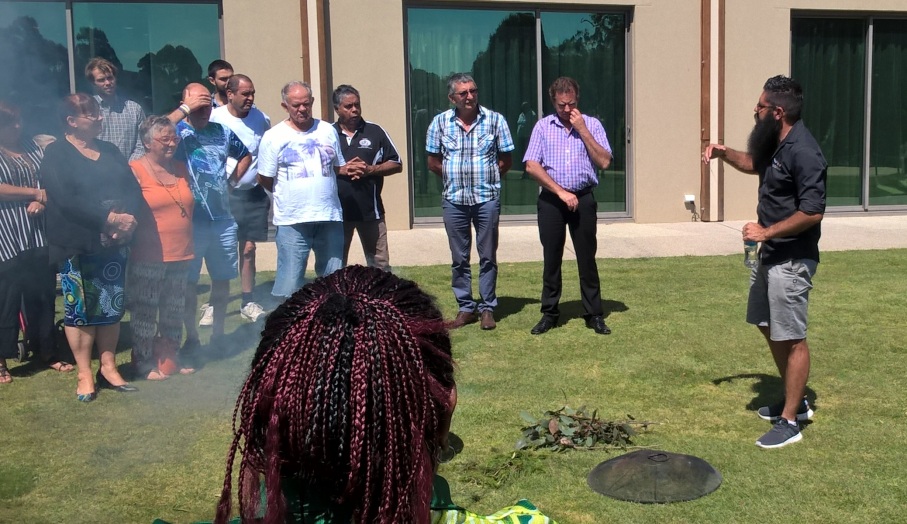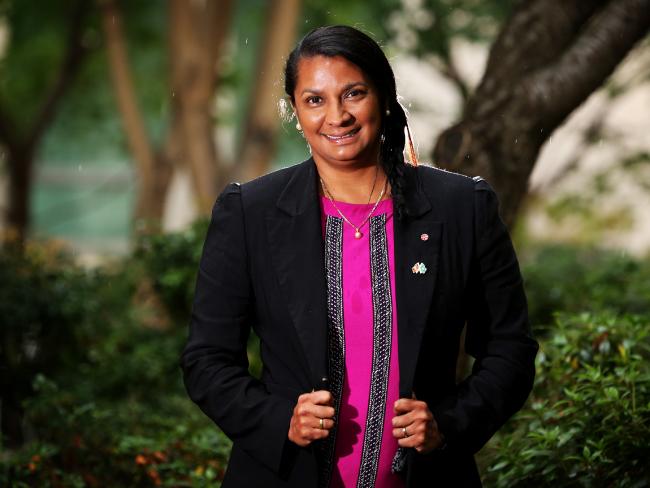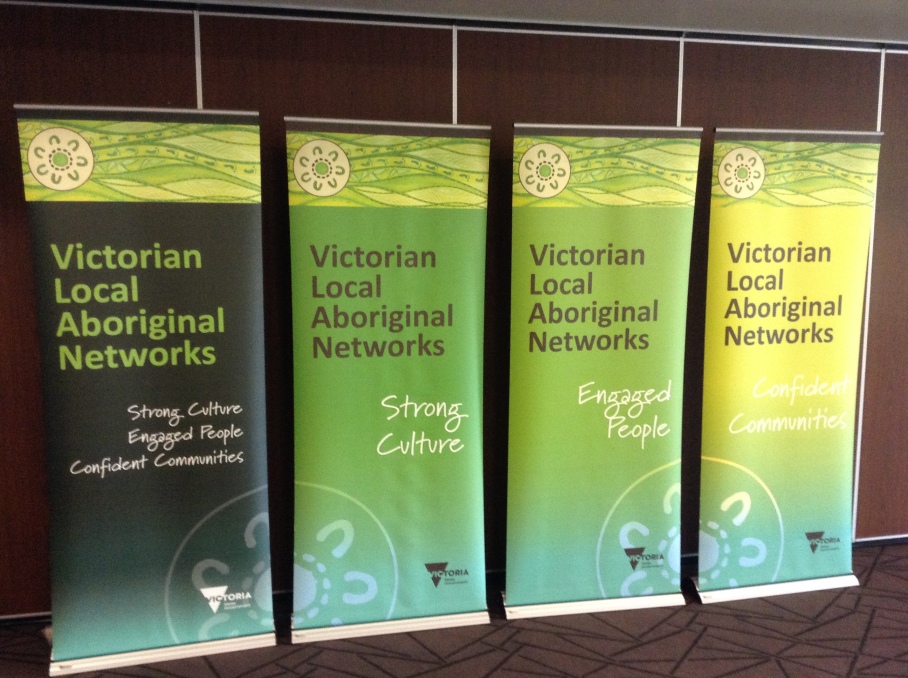Local Aboriginal Networks Victorian – strong culture, engaged people, confident communities.
During the month I attended the state wide gathering of the Local Aboriginal Networks not only as part my NDCO involvement across several of the LAN’s in my region but also as a community member. This is the second state wide meeting which was held on the 22nd and 23rd of November at Creswick – Dja Dja wurrung on the fringe of the Wombat State Forest.
First big thanks goes to Laurence Moser as MC for the two days, who vaguely kept things to some sort of order as per the agenda.
Naturally welcome to country was the first order of the gathering and a fantastic job was done by local Dja Dja Wurrung, Trent Nelson. I particularly appreciated his reference to the growing trend of growing up off country and mix of different groups across clan lines in particular regions and more than ever the importance of the welcome to country ceremony.

Trent Nelson welcomes delegates to country
Chris Saunders from Aboriginal Victoria was tasked with the first presentation of the day, giving an overview of the background of the LAN’s and what is hoped to be achieved in the next two days, “Whatever you do matters, be it for better or worse. But we need to try all options.” For details of the LAN’s and the five year plan details please view the dedicated web page – https://www.vic.gov.au/aboriginalvictoria/community-engagement/local-aboriginal-networks.html
This includes a wonderful summary video available on Youtube: https://www.youtube.com/watch?v=mtdILZs_q9A
Also – from a back ground point of view check out my previous report from one of the regional LAN meetings that occurred in Wangaratta 2016. https://ndcoacrossthedesk.wordpress.com/2016/10/27/lan-forum-wangaratta/
Katrina Touzeau, also from Aboriginal Victoria was tasked with reporting on the progress aspect of what the LAN’s have been up to from a collective data point of view. One really good analogy presented at the outside was the ‘rock to ripple approach’. We all know that if we throw a rock in a pool of water there is a splash and there are ripples. Whatever event or project you do is the throwing of the rock. How big is splash, which is relatively easy to measure, equates to things like number of attendees at an event as an example, but how do we measure the ripples. This underpins a continuing challenge for community programs and similar social welfare programs. Very quickly, re some of the “splash” data I noted the following, there was; 139 funded projects / 59 completed / average of $1739 spent per project / 42 jobs create from funded projects but also the reality is that in kind funding (donation of goods and services) equates to a 1 for 1 dollar input. In addition – 258 volunteers gave 3527 hour across 26 projects 2016-17
In regards the breakdown of activities within priority areas projects,
- Strengthening Culture:135
- Support for Young People: 95
- Economic Participation: 64
- Building a Stronger LAN: 117
- Community Planning and Partnerships: 76
- Working with Local Government: 41
Each of the tables (around a dozen tables with at least ten to each table), had the opportunity to discuss and highlight some of the projects in their areas. Given that the plans of most areas have only been operational for around twelve months I was staggered to see the breadth and depth of activities happening right across the state. Talk about the government getting bang for their buck re this program.
***Very quick aside – really enjoyed the scratch art paper that was left on the individual tables for delegates to engage with during the conference. Checkout the below photo’s. I can also say that I found these sheets in the reject shop locally and highly recommend them as an engagement tool and will do some experimenting through my work with Burraja.
During the rest of the afternoon each of the LAN brokers had the opportunity to facilitate an overview of each particular priority area. (See above or refer to LAN plan). From a personal point of view I very much enjoyed having the opportunity to participate in a question and answer session regarding the importance of engaging with councils from a LAN perspective. This included the showing of three videos of which I was lucky enough to participate in and I look forward to featuring the link when made fully available.
Important key learnings for some of the projects –
Project planning, budgeting and value adding / Communication / the importance of promotion and media /having enough product for demand. (Where relevant). I guess the key message really is that there are so many wonderful projects happening across all areas. Knowing that without the LAN there would be a very empty space except for possibly NAIDOC and maybe some other smaller non-linked programs.

Nova Peris
That night attendees had the opportunity to network over dinner with a key highlight being the address from Nova Peris of which I noted several key points.
- “Despite my achievements they pale into insignificance when you consider what my grandmother went through and how they survived and then similar for my mother. I had to stand on their shoulders to reach the outcomes that I managed to achieve.”
- Regarding her time spent in Parliament. “It was more like a category six storm when compared to the category five storms of the top end.”
- Mention of her direct involvement in the health checks program that actually instigated her drive towards parliament. Through the health check process she saw the inequality and the reality of the divide akin to a war on the Aboriginal community.
- There was some talk of the issue regarding the constitution recognition argument, “we don’t need it because it’s not applicable. We were here long before any constitution. What we do need is for our kids to be culturally strong. And you also have to realise that you have to give up something to get something.”
- Now working for DHHS as part of the Korin Korin Balit-Djak: Aboriginal health, wellbeing and strategic plan 2017-2027. One of her personal insights into this area is the importance that sports can play in the health of our young people. She further articulated the value that the Clontarf academies have brought across the nation in this regard. But a very evident gap in this piece of the puzzle is the fact that this primarily addresses the needs of our young men whilst the girls miss out. Further to this I really appreciated the comment, “Educate a boy you educate an individual, educate a girl you educate a whole community.”
Day 2
This was a chance for the LANs to feedback to the administrator’s things they have identified as needing some work or assistance in capacity building. This included many categories such as: food handling, first aid, applying for acquitting funding, overcoming lateral violence/ cultural safety and healing, governance, public speaking, influencing and negotiating, social media / being deadly online, mental health first aid, risk management, event management, reporting and evaluation.
What I really take away from this session is how well some LAN’s actually achieve this capacity building by bringing these skills into their LAN’s to directly assist, train or advise where possible. From a personal perspective and being closely associated with the Wodonga LAN it is this very reality that I have witnessed in that LAN and I look forward to seeing more of this as time passes.
In regards the session on day two regarding the progress of the treaty I refer you to the following two documents: (1) Treaty Fact Sheet
https://www.vic.gov.au/system/user_files/Documents/av/Aboriginal_Treaty_Fact_Sheet.pdf & (2) Victorian Treaty Advancement Commission.
https://www.vic.gov.au/aboriginalvictoria/treaty/victorian-treaty-advancement-commission.html
I have very much aligned myself to the limitations of the Victorian action in this regard as per the fact sheet – 1. The parties must agree on what is necessary and just. 2. As a state within the Commonwealth, the Victorian Government can only agree to what is within its own constitutional powers. 3. As one state within the Federation, Victoria can only advocate for what is included in a national treaty.
Given this context a more important aspect of action is addressing the absence of Registered Aboriginal Parties from a lot of local areas.
Big thanks to organisers and attendees for a productive and welcoming event. I look forward to further collaboration in the near future as we ‘surf the ripples’ to long lasting and positive change.


